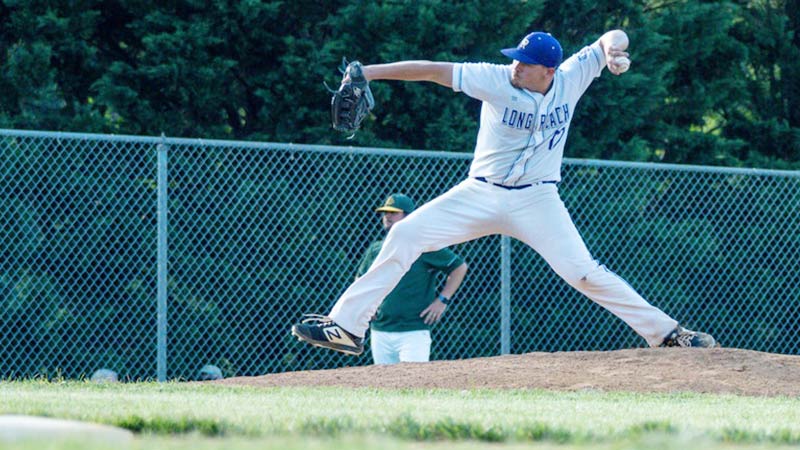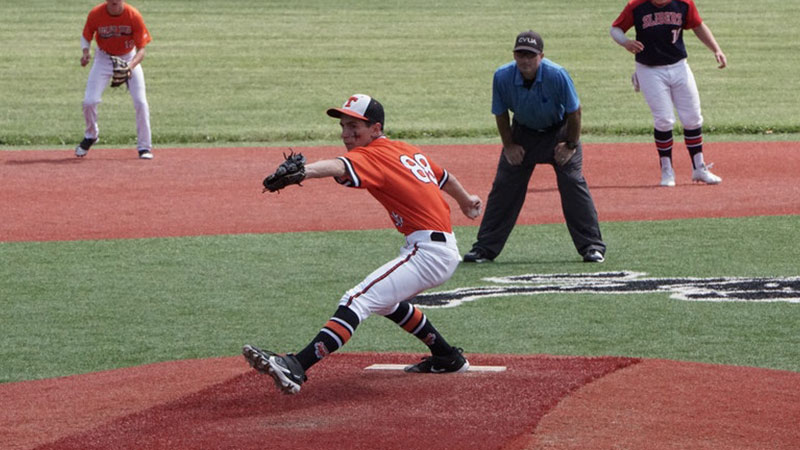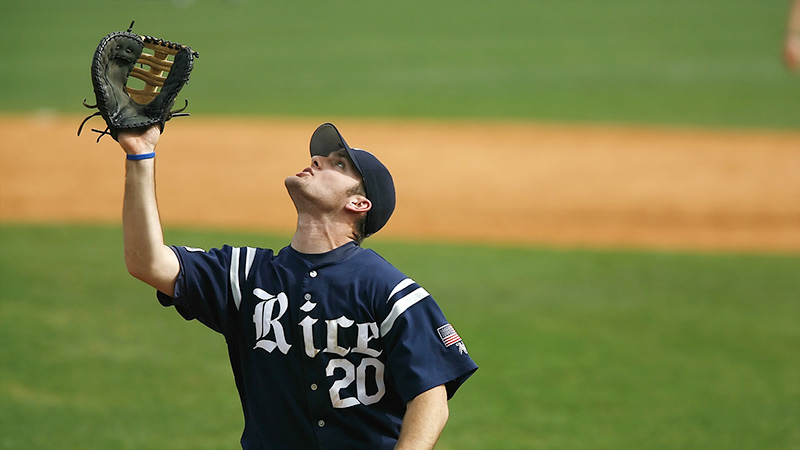In the game of baseball, the placement of gloves on players’ hands is a fundamental aspect that ensures smooth gameplay and effective performance. The question of “What hand do you wear a baseball glove on?” arises as players consistently wear gloves on their non-dominant hands.
This convention allows players to maintain their throwing abilities while still being able to catch the ball efficiently.
The placement of the glove on the non-dominant hand optimizes players’ control, accuracy, and power during throws, ultimately impacting the overall success of their gameplay.
By delving into the historical perspective, the evolution of glove design, and the impact on hand placement, we can gain a comprehensive understanding of this intriguing aspect of baseball.
On Which Hand the Baseball Glove Should be Used?
In baseball, the glove is worn on the non-dominant hand, which is typically the left hand for right-handed individuals and the right hand for left-handed individuals.
The reason for this is to allow the dominant hand, usually the right hand, to have better control and accuracy when throwing the ball.
The glove is worn on the opposite hand to provide protection and facilitate catching and fielding the ball, leaving the dominant hand free to make the throws. In the following parts of this post, we will dig into this matter more closely with some factors behind the phenomenon.
The Dominant Hand and Throwing in Baseball

The dominant hand refers to the hand that an individual naturally favors and is typically stronger and more skilled with. In the context of baseball, the dominant hand plays a crucial role in the throwing aspect of the game.
When a player throws a baseball, they need to generate power, accuracy, and control. The dominant hand provides the necessary strength and dexterity to execute an effective throw.
It allows players to grip the ball firmly, generate force from their arms and shoulder, and release the ball with precision.
Why Players Throw With Their Dominant Hand
Players throw with their dominant hand primarily because it offers better control and accuracy. Years of practice and muscle memory development contribute to the dominant hand becoming more proficient at throwing.
It is easier for players to fine-tune their throwing mechanics and consistently deliver accurate throws using their dominant hand. Switching to the non-dominant hand for throwing would require significant adjustments and compromise the player’s throwing ability.
Impact of Throwing Hand on Glove Placement
The choice of throwing hands directly influences where players wear their baseball gloves. Since the throwing hand is the dominant hand, it needs to be free from any encumbrance, such as wearing a glove, to execute throws effectively.
This leads to the placement of the glove on the non-dominant hand. By wearing the glove on the non-dominant hand, players ensure that their throwing hand remains unobstructed, allowing them to grip the ball securely and make accurate throws.
The glove on the non-dominant hand serves the purpose of catching the ball, enabling quick transfers to the throwing hand for seamless and efficient gameplay.
Catching and the Non-dominant Hand in Baseball

Catching in baseball refers to the act of receiving a thrown or batted ball using a baseball glove. It requires players to position themselves strategically to intercept the ball and secure it within the glove.
Catching is a fundamental skill that players develop to effectively field and control the ball during gameplay.
Importance of Having a Free Hand for Catching
Having a free hand for catching is crucial for several reasons. Firstly, it allows players to have better control and feel of the ball when it makes contact with the glove.
With the non-dominant hand being dedicated to catching, players can focus on guiding the ball into the glove and cushioning its impact. This helps prevent potential errors or drops that may occur if the throwing hand is occupied with a glove.
Secondly, having a free hand enables players to quickly transition from catching to throwing. In many game situations, a player may need to make a swift and accurate throw after catching the ball.
By keeping the throwing hand free, players can seamlessly transfer the ball from the glove to the throwing hand, minimizing the time taken and increasing the efficiency of their gameplay.
Reasons for Wearing the Glove on the Non-dominant Hand
Ensuring Availability for Throwing
The primary reason for wearing the glove on the non-dominant hand in baseball is to ensure that the dominant hand, which is typically stronger and more skilled, remains available for throwing.
since throwing demands more strength, control, and accuracy than catching, it is advantageous to keep the throwing hand free from any equipment.
Catching and Securing the Ball
By wearing the glove on the non-dominant hand, players can catch the ball with their non-dominant hand and secure it in the glove.
The glove provides a protective and cushioned pocket to trap the ball and prevent it from bouncing out. This allows players to quickly react to the ball and ensure a successful catch.
Swift Transfer to the Throwing Hand
After catching the ball with the non-dominant hand, players can swiftly transfer it to the throwing hand for a throw. Since the throwing hand is not encumbered by a glove, players can easily grip the ball and prepare for the throw without any hindrance.
This seamless transfer minimizes the time between catching and throwing, enabling players to make fast and accurate throws.
Consistency in Throwing Mechanics
Wearing the glove on the non-dominant hand allows players to maintain consistency in their throwing mechanics. The throwing hand, being the dominant hand, is typically more skilled and accustomed to the specific motion required for accurate throws.
By keeping the glove on the non-dominant hand, players can ensure that the throwing motion remains consistent, leading to more precise and reliable throws during gameplay.
Minimizing Disruption and Adjustment
Switching the glove to the throwing hand after catching would require adjusting the grip and position of the ball, which could disrupt the fluidity and accuracy of the subsequent throw.
By wearing the glove on the non-dominant hand, players eliminate the need for such adjustments. They can catch the ball, secure it in the glove, and transfer it to the throwing hand seamlessly without any disruptions, enhancing the overall efficiency of their gameplay.
The Efficiency of Wearing the Glove on the Non-dominant Hand
Wearing the glove on the non-dominant hand is highly practical for several reasons. Firstly, it allows players to maximize the use of their dominant hand for throwing, which is a critical aspect of the game.
By keeping the throwing hand free, players can unleash their full throwing potential without any hindrance. This practicality translates into stronger and more accurate throws, giving players a competitive advantage on the field.
Secondly, wearing the glove on the non-dominant hand simplifies the catching process. Since catching primarily involves guiding the ball into the glove and softening its impact, it can be effectively executed with the non-dominant hand.
This practical arrangement enables players to focus on positioning themselves properly to make the catch, without having to worry about adjusting their throwing hand or removing the glove before throwing.
How It Allows for Quick Transitions
Wearing the glove on the non-dominant hand facilitates seamless transitions between catching and throwing. After making a catch, players can swiftly transfer the ball from the glove to the throwing hand, as the throwing hand remains unencumbered.
This quick transition minimizes the time taken between catching and throwing, allowing players to make rapid and accurate throws to their intended targets.
It enhances the overall speed and fluidity of gameplay, crucial in situations where split-second decisions and actions can make a significant difference.
Examples of How It Benefits Players
The glove placement on the non-dominant hand benefits players in various game situations. For instance, when fielding ground balls, players can smoothly scoop up the ball with their non-gloved hand, transfer it to the glove on their non-dominant hand, and make a swift throw.
This quick transfer and release allow them to turn double plays or throw out runners with precision.
In outfield situations, wearing the glove on the non-dominant hand enables outfielders to catch fly balls or make diving catches without any interference from the glove.
Once the catch is made, they can promptly retrieve the ball from the glove and unleash a powerful throwback to the infield, preventing runners from advancing or scoring.
This efficiency in catching and throwing allows infielders to make critical outs and prevent runners from advancing.
Wearing the glove on the non-dominant hand enhances practicality and efficiency in baseball. It enables quick transitions between catching and throwing, benefiting players in various game situations where speed, accuracy, and fluidity are paramount.
Historical Perspective and Evolution of Glove Placement
Baseball gloves have a rich history that dates back to the early days of the sport. In the early 19th century, baseball players didn’t use gloves and would catch the ball barehanded.
As the game progressed and the ball became harder and faster, players began experimenting with various forms of hand protection.
The first recognized baseball glove was created in the 1870s by Charles Waite, a catcher for the Detroit Wolverines. This glove was made of leather and padded with strips of felt to provide some level of protection.
However, it was primarily used by catchers and was not commonly worn by other players at the time.
How Glove Placement Evolved Over Time
As baseball gloves gained popularity, players started to wear them more frequently. In the early stages, players would wear gloves on both hands, as there was no specific convention regarding glove placement.
It wasn’t until the late 19th century that consistent glove placement began to emerge.
The evolution of glove placement was driven by practicality and the need for players to have a free hand for throwing. Players realized that it was more efficient to wear the glove on their non-dominant hand, allowing their dominant hand to be free for throwing.
Impact of Glove Design and Improvements on Hand Placement
The design and improvements of baseball gloves over time have had a significant impact on hand placement. As glove technology advanced, manufacturers focused on enhancing the functionality and performance of gloves to provide better protection and support for players.
With the development of specialized glove designs for different positions, players could choose gloves tailored to their specific needs. These position-specific gloves were designed to optimize catching abilities while still allowing for efficient hand placement.
For example, infielder gloves are typically smaller and offer quicker ball transfer, while outfielder gloves have a larger surface area to assist with catching fly balls.
The historical evolution of baseball gloves has influenced the placement of gloves on players’ hands. Practicality and the need for a free-throwing hand have driven the convention of wearing the glove on the non-dominant hand.
Evolution of Baseball Glove Placement
Era/Period | Glove Placement |
Early 19th century | No gloves worn |
1870s | Catchers wear gloves |
Late 19th century | Gloves worn on both hands (no standardized placement) |
20th century | Convention of wearing a glove on a non-dominant hand for most players |
Modern era | Continued adherence to the glove on non-dominant hand, with advancements in glove design and technology |
FAQs
Why do players wear gloves on their non-dominant hands in baseball?
Players wear gloves on their non-dominant hands to keep their dominant hand free from throwing. It allows them to maximize their throwing abilities and ensures efficient transitions between catching and throwing.
Can players switch their glove placement if they are ambidextrous?
Yes, ambidextrous players have the flexibility to choose their glove placement based on their personal preferences. They can wear the glove on either hand depending on which hand they feel more comfortable catching with.
Are there any disadvantages to wearing the glove on the non-dominant hand?
Wearing the glove on the non-dominant hand can sometimes lead to a slightly longer transition time from catching to throwing compared to wearing the glove on the dominant hand. However, players practice extensively to minimize this transition time and make it as seamless as possible.
Are there any specific rules regarding glove placement in baseball?
Major league baseball and most baseball leagues do not have specific rules dictating glove placement. However, it has become a convention for players to wear the glove on their non-dominant hand for practicality and efficiency.
Do left-handed players wear their gloves on the opposite hand compared to right-handed players?
Yes, left-handed players wear their gloves on their right hand, which is their non-dominant hand for throwing. This follows the same principle of keeping the dominant hand free for accurate and powerful throws.
Conclusion
The placement of baseball gloves on the non-dominant hand has become the standard convention in the sport. It allows players to maximize their throwing abilities by keeping their dominant hand free.
While there may be some minor disadvantages and exceptions, wearing the glove on the non-dominant hand remains the preferred choice for most players.
The historical evolution of glove placement showcases the sport’s adaptation to the changing needs and demands of the game. Hope this article answers some of the questions on the topic. Thank you.







